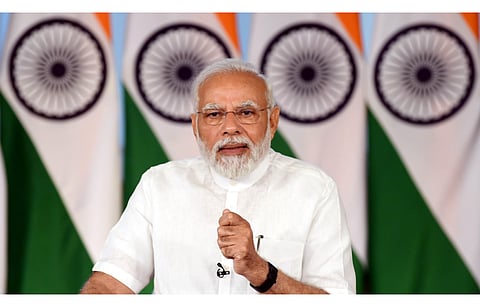

India's Union Cabinet has increased the targeted share of non-fossil fuel-based energy resources in national installed power capacity to reach 50% by 2030 in its Intended Nationally Determined Contribution (NDC) to meet Paris Agreement objectives. The new target is up 10% points from 40% as declared previously.
In its October 2015 NDC submitted to the United Nations Framework Convention on Climate Change (UNFCCC), India had committed to a non-fossil fuel share of power generation capacity of 40% by 2030, reduce the emissions intensity of GDP by 33% to 35%, compared to 2005 levels, and create an additional carbon sink of 2.5 to 3.0 billion tons of CO2 through additional forest and tree cover.
Now under its updated NDC, India will aim to reduce its emissions by 45% by 2030 compared to 2005 level. It claims this is a step towards achieving the overarching goal of becoming net zero by 2070 (see India Goes For Net Zero By 2070).
"The updated framework, together with many other initiatives of the Government, including tax concessions and incentives such as Production Linked Incentive scheme for promotion of manufacturing and adoption of renewable energy, will provide an opportunity for enhancing India's manufacturing capabilities and enhancing exports," reads a government statement. "It will lead to an overall increase in green jobs such as in renewable energy, clean energy industries- in automotives, manufacturing of low emissions products like Electric Vehicles and super-efficient appliances, and innovative technologies such as green hydrogen, etc."
The NDC will be implemented over the period from 2021 to 2030 through various programs and schemes.
However, the government added a caveat to the achievement of these goals by saying that so far it has largely financed its climate actions from domestic resources. Now the country will 'require its due share from such international financial resources and technological support'.
"India's NDC do not bind it to any sector specific mitigation obligation or action. India's goal is to reduce overall emission intensity and improve energy efficiency of its economy over time and at the same time protecting the vulnerable sectors of economy and segments of our society," it added.
There are mixed reactions to this development from various quarters. Council on Energy, Environment and Water Fellow (CEEW) Dr Vaibhav Chaturvedi said the share of non-fossil in India's power generation capacity has already crossed 41%. "GoI should now follow this path with explicit inclusion of the 2070 net-zero pledge in its yet-to-be submitted long-term strategy to the UN," he added.
Energy Economist & India Lead at the Institute for Energy Economics and Financial Analysis (IEEFA), Vibhuti Garg pointed out that the revised NDC 'falls short of some actionable targets' to achieve 2070 net zero goal including absence of 500 GW of non-fossil fuel-based capacity by 2030. Some supply-side targets will give some better direction to various stakeholders.
India aims to achieve 100 GW of installed solar power capacity by December 2022, however till the end of June 2022 the number had reached only 57.7 GW, as per the Ministry of New and Renewable Energy (MNRE) out of 114.06 GW total renewable energy capacity.
